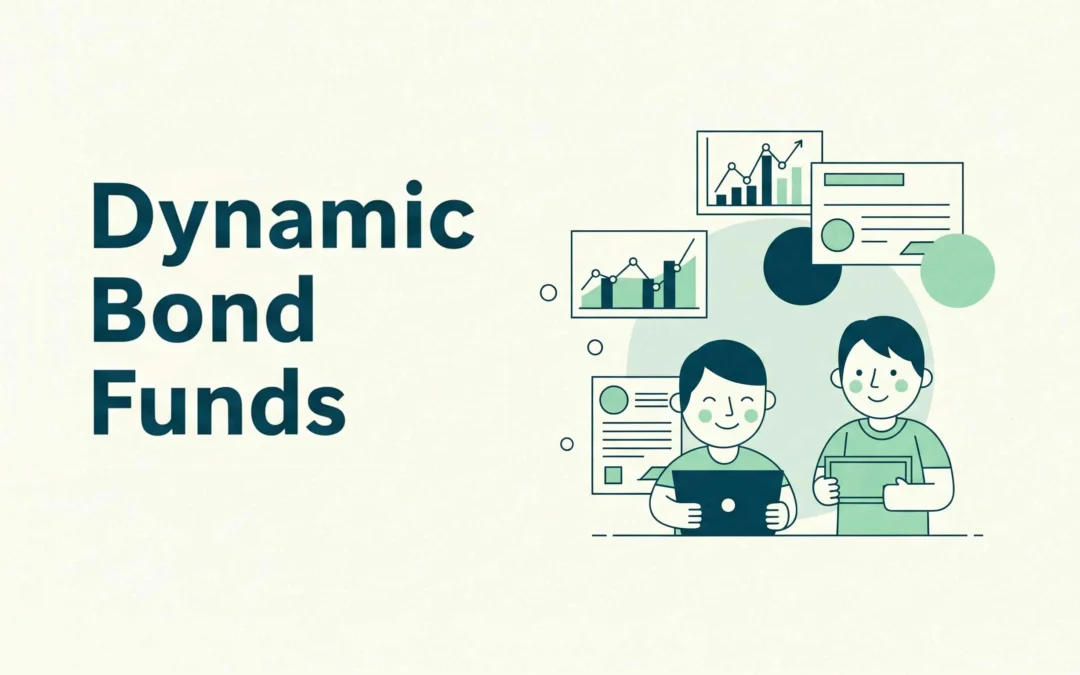Does investment feel like a commitment to you? What if you were given a chance to invest in a mutual fund and given the liberty to change the duration in between? Sounds fascinating, right? Dynamic bond funds are designed to sustain in the ever-changing market. The interest rates change due to various factors that may not be foreseeable. But, having that farsightedness is not required if you choose to invest in these bonds.
Let us know in detail about the dynamic bond funds and understand if the risk is equivalent to the reward or not.
What Are Dynamic Bond Funds?
Debt mutual funds that actively adjust duration and credit exposure in response to market conditions are known as dynamic bond funds. These funds give fund managers the flexibility to switch between short-term and long-term instruments in response to changes in interest rates and the state of the economy.
Key Features:
- Flexible Duration Strategy: Depending on changes in interest rates, fund managers can modify the maturity profile.
- Active Management: In response to market signals, the portfolio fluctuates actively.
- Broad Investment: Could consist of corporate bonds, money market instruments, government securities, etc.
Example:
| Funds | Return (1Y) |
| ICICI Prudential All Seasons Bond Fund Direct Plan Growth | 10.55% |
| Aditya Birla Sun Life Dynamic Bond Retail Fund Direct Growth | 10.96% |
Understanding the Pros and Cons
Pros:
- Flexibility in Duration Management: To capitalise on interest rate cycles, fund managers can switch between long- and short-term bonds.
- Increased Potential for Return: Being adaptable makes it possible to seize chances across the yield curve, particularly when interest rates decline.
- The process of diversification: Invests in a variety of money market instruments, corporate bonds, and government securities.
- Ideal for Unpredictable Rate Cycles: Reduces risks in situations where the rate direction is unclear.
- Expert Management: Macroeconomic analysis is used by knowledgeable fund managers to inform their investment choices.
Cons:
- Call Risk on Interest Rates: Inaccurate interest rate forecasts may result in underperformance or losses.
- Increased Volatility: Because of variations in duration, NAVs may fluctuate more than other debt funds.
- Difficult for Individual Investors: difficult for novice or cautious investors to monitor or comprehend.
- Fund Manager Determines Performance: Subjectivity is introduced by the heavy reliance on the manager’s skill.
- Like other debt funds, it will be taxed according to income slabs, which will lower post-tax returns.
Understanding Rewards and Risks
Benefits (Opportunities)
- Tactical Returns: These funds can profit from changes in interest rates by switching between short- and long-duration bonds.
- Market Responsiveness: Compared to fixed-duration funds, their dynamic nature enables them to adjust to shifting macroeconomic conditions more quickly.
- Diversified Exposure: Lowers concentration risk by distributing investments among a range of corporate and government debt instruments.
Hazards (Difficulties)
- Interest Rate Risk: In a volatile market, a call with the incorrect duration could cause capital erosion.
- Volatility in NAV: Conservative investors may find short-term swings caused by frequent adjustments unsettling.
- Dependency on Fund Manager: Subjectivity is introduced because returns are largely dependent on the expertise and vision of the fund manager.
Who Should Consider Investing in Dynamic Bond Funds?
Not every investor is a good fit for dynamic bond funds. They are appropriate for people who comprehend debt markets and are able to tolerate a certain amount of volatility in exchange for possibly larger returns.
Ideal For:
- Investors with a medium to long time horizon are advised to hold for at least three to five years.
- Perfect for people who can handle short-term NAV swings but still want exposure to debt.
- Tax-Efficient Debt Investors: For investments made on or after April 1, 2023, all capital gains from debt mutual funds including dynamic bond funds are taxed at your income tax slab rate, regardless of holding period. Indexation benefits are no longer available
Bottomline
The conclusion can be drawn that dynamic bond funds are a good investment option, but if dealt with caution. The list of pros and cons stated above gives close insight into the risks associated with them. The chances of profits are accompanied by the probability of loss, depending on the market conditions. The investors must analyse the funds and see if the qualification and history of fund managers, as they are responsible for subjective changes.
Analysing may not completely eliminate the risk, but it surely reduces it.
Written by: Tanya Kumari


